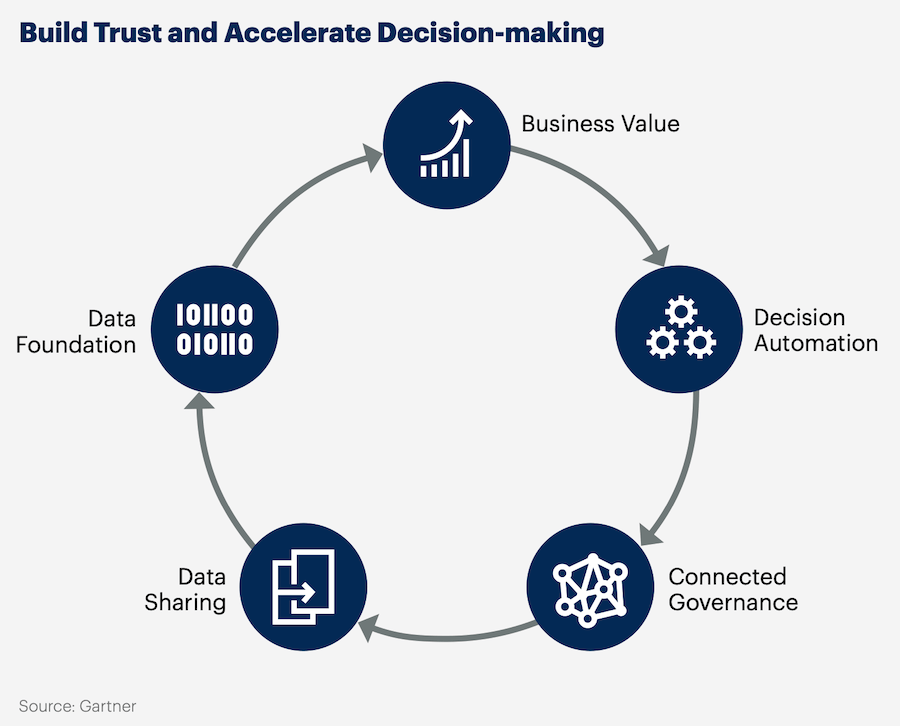In today’s business landscape, achieving success and launching digital projects are powered by data and analytics (D&A) strategies that grow in alignment with organisational goals. The ability to quickly adapt D&A capabilities is crucial for developing the capacity to sense and respond effectively, pushing companies to achieve record-breaking rates of innovation to keep up with evolving demands.
A recent Gartner survey indicates that by the end of the year, the majority of effective CDAOs will come from business rather than IT backgrounds, as companies place greater emphasis on the value of digital initiatives. It seems that D&A is increasingly recognised as a vital tool for tackling present business issues and exploring prospects. D&A leaders must provide their organisations with reliable, trusted data to support decision-making processes from the executive level down to the operational level.
How to scale measurable digital business growth
As numerous companies aim to embrace a data-centric approach, they link their Data and Analytics (D&A) efforts to quantifiable business results and the goals of their stakeholders. They gain additional advantages through increased autonomous solutions, which leads to greater efficiency and dependable, consistent procedures. Organisations that are data-driven recognise that data is a valuable resource that demands management, cooperation, and distribution. They achieve this by implementing a suitable scalable infrastructure. Leaders of D&A and their existing D&A strategies must enhance and expand the measurable impact on business by utilising trusted D&A in the organisation’s decision-making processes.

What is the role of data and analytics in business?
The function of data and analytics is to empower companies, their workers, and their leaders to make more informed choices and enhance the results of those decisions. This encompasses all kinds of decisions, from broad to detailed, immediate to recurring, strategic to tactical, and operational. Concurrently, data and analytics can reveal new inquiries, as well as creative answers and chances that company leaders might not have thought of before.
Forward-thinking companies utilize data in various manners and frequently depend on external data sources beyond their control to make wiser business choices. Data and analytics also serve as a driving force for digital transformation, as they facilitate quicker, more precise, and more pertinent decisions in complex and rapidly evolving business environments.
People and groups within organisations make choices, such as when someone decides to purchase a product or service, or when a company figure out the best way to meet the needs of a customer or citizen. Making decisions based on data involves using information to enhance the way decisions are made. This concept is about developing a decision framework, which may include methods that suggest specific actions to take.
Other methods include descriptive, diagnostic, or predictive analytics (also referred to as “What are core analytics techniques?”). Each method is useful for different types of decisions. It’s important to note that decisions not only lead to actions but also play a role in deciding when to refrain from taking action. Forward-thinking companies are integrating data and analytics into their business strategies and digital transformations by envisioning a business that is driven by data, measuring and sharing the results of business activities, and encouraging changes that are supported by data.
How does data literacy enable successful digital growth?
Data literacy is the skill to interpret, create, and share data within its context. It demands knowledge of data origins and structures, analytical approaches and tools, and the skill to explain how the data is used and its value. This might lead one to believe that every employee needs to be trained as a data scientist or data analyst, but that’s not the reality.
From a business viewpoint, data literacy can be seen as a program designed to assist business leaders in asking more insightful questions about the data they possess. Instilling data literacy within a company is a challenge that involves changing the company’s culture. Data and Analytics (D&A) is becoming increasingly integrated into every part of business, into communities, and even into our personal lives. Being able to communicate in the language of data, or being data literate, is becoming crucial for a company’s success. Yet, achieving this kind of significant, lasting change demands that employees acquire new skills and adopt new behaviour.
Thus, it’s crucial to focus more on the aspect of change management within the Data and Analytics (D&A) strategy, utilising the expertise of leaders and change champions, and tackling both the ability to understand data and the overall mindset towards it. The journey towards data literacy begins with a leader committing. For instance, the Chief Information Officer (CIO) or the head of Data Analytics, in collaboration with the Finance department (often led by Business Intelligence [BI] experts) and the Human Resources (HR) sector (specifically the Development and Training teams), can launch initiatives aimed at enhancing data literacy among colleagues.
These initiatives should equip their peers with the necessary skills and tools to integrate Data and Analytics into their departments effectively. Within the broader scope of a data literacy initiative, the art of data storytelling plays a significant role in fostering positive and meaningful engagement with stakeholders. Employing methods to present data and insights in the form of data-driven narratives, it simplifies the process for stakeholders to comprehend, act upon, and utilise the information shared.
The stages for ensuring successful digital growth
Leaders in data and analytics today face the challenge of providing their organisations with reliable and credible data at the appropriate time and place to support decision-making. Building a strong data and analytics program requires numerous projects to meet the organisation’s data goals.
There’s a significant demand to ensure that every project delivers value, whether it’s strategic, operational, or related to governance. Thankfully, there are established processes and tasks that data and analytics leaders can employ to bring all parties together and achieve the desired results towards a specific objective. Use these five steps to enhance the measurable effectiveness of your data and analytics program.
i. Create vision and strategy – establish stakeholder buying
ii. Establish an operating framework – develop a balanced operating model
iii. Cultivate culture and establish governance – define the data-driven culture and business-oriented practices for adaptive D&A governance
iv. Manage D&A value – demonstrate value from D&A investments and products
v. Refine and progress – Enhance D&A maturity and continuous improvements
Thanks to AI, and its naturally autonomous functionality multiple AI machine learning software providers now enable instant installation to resolve this issue for you.
We have provided a list of the top 30 hyper-personalisation providers with their distinctions for ease of reference and choice.





